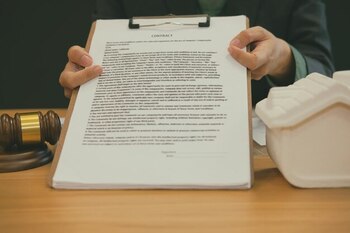Legal clauses in lease agreements that you need to understand

Legal clauses in lease agreements are essential for protecting both landlords and tenants. Understanding them not only prevents misunderstandings but also ensures harmonious living and avoids unpleasant surprises. From the duration of the contract to responsibilities in case of damages, every detail matters. This article will guide you through the most relevant aspects you need to know to secure a solid and fair contract in your next real estate transaction.
What is a lease agreement?
A lease agreement is a legal contract between two parties: the lessor, who is the property owner, and the tenant, who wishes to use that space in exchange for periodic payment. This document establishes the conditions under which the rental will take place, including the duration of the lease, the amount of rent, and the rules that both parties must follow. By signing a lease agreement, both parties are agreeing to and committing to comply with the stipulated terms, which provides legal security in the relationship.
The lease agreement not only regulates economic aspects such as rent and security deposits, but also addresses important responsibilities. For example, it may include clauses about property maintenance, policies regarding pets or subleases, as well as provisions in case of breach. Understanding these elements is essential to avoid future conflicts and ensure that both landlords and tenants are clear about their obligations and rights throughout the duration of the contract.
2. Duration of the contract: What you need to know
The duration of the lease contract is one of the most important clauses to consider when signing an agreement. Generally, contracts can be short or long term, and this choice will have a significant impact on both the tenant and the landlord. A short-term contract may offer flexibility, ideal for those who do not wish to commit long-term; however, it may also involve the need to frequently seek new options. On the other hand, a long-term contract provides stability and may result in more favorable conditions, such as lower monthly rents. It is essential that both parties understand the terms related to the duration of the contract and the possible renewals. This includes knowing if there are penalties for early termination or if there is the option to automatically renew the agreement at the end of the established period. Discussing these issues from the beginning will help avoid unpleasant surprises in the future and ensure that both sides are aligned regarding their expectations during the term of the lease. Clarity in this clause is key to enjoying a peaceful and respectful leasing relationship.
3. Responsibilities of the landlord: Beyond the rent
The responsibilities of the landlord go far beyond the simple collection of monthly rent. One of the fundamental duties is to ensure that the property is in habitable and safe condition for the tenant. This includes making necessary repairs, maintaining the facilities in good condition, and ensuring that all basic services, such as water, electricity, and heating, are functioning properly. Neglecting these aspects can not only cause inconvenience to the tenants but could also lead to legal disputes if it is deemed that the landlord is failing to meet their contractual obligations.
Additionally, the landlord must be transparent about any changes that may affect the tenant, such as rent increases or modifications to the contract rules. They are also responsible for notifying the tenant about visits to the property for maintenance or other reasons, thus respecting their right to privacy. In this sense, clear and open communication can prevent misunderstandings and contribute to a more harmonious relationship between both parties. By understanding these responsibilities, both landlords and tenants can work together to create an environment of trust and mutual respect.
4. Tenant obligations: Maintenance and care of the property
The tenant has the primary responsibility to keep the property in good condition, which includes making minor repairs and general upkeep of the space. This ranges from basic tasks like cleaning and disinfecting to addressing more specific issues such as the maintenance of appliances or plumbing. Ignoring these obligations can result in financial penalties or the loss of the security deposit at the end of the lease. Therefore, it is crucial for tenants to familiarize themselves with their duties to avoid conflicts with the landlord.
Additionally, it is important to understand that property maintenance not only involves keeping its appearance but also respecting community regulations and taking care of common elements if it is a building or residential complex. Tenants should be aware that any damage caused by negligence could be considered a breach of contract and could lead to legal action by the owner. Therefore, promoting responsible practices and proactively communicating with the landlord about any issues is essential to ensure a harmonious relationship throughout the entire rental period.
5. Security deposit clauses: What to consider?
Security deposit clauses are a crucial aspect of lease agreements that deserve special attention. This deposit, usually equivalent to one or two months' rent, acts as a guarantee for the landlord in case the tenant causes damage to the property or fails to meet their financial obligations. Therefore, it is essential for both parties to understand the conditions under which this amount will be withheld or returned. A clear contract must specify the circumstances under which deductions from the deposit may be made, as well as the timeframe established for its return once the contract has ended.
It is also important to consider the legality and transparency in the management of the security deposit. Landlords must provide a receipt for the deposit received and detail how that money will be maintained, whether in a separate account or under certain specific conditions. Likewise, tenants have the right to receive clear explanations about any deductions applied at the time of the deposit's return. By establishing these clauses explicitly from the beginning of the contract, potential conflicts and misunderstandings are minimized, fostering a more harmonious relationship between landlord and tenant.
6. Early termination of the contract: Rights and obligations
The early termination of the lease agreement is a clause that allows the parties to end the agreement before the originally agreed date. Both landlords and tenants must be aware of their rights and obligations in this context. For example, the landlord may have the right to demand compensation for the remaining months of the contract if the tenant decides to leave early without just cause. On the other hand, the tenant may also be protected by laws that allow them to terminate the contract due to special circumstances, such as serious issues with the housing or unforeseen personal situations. It is crucial for both parties to be informed about the specific conditions that allow for this early termination. Generally, prior written notice and compliance with certain deadlines are required, which vary according to local legislation or the terms of the contract itself. Clarity on these aspects not only helps to avoid future disputes but also promotes a more transparent and respectful relationship between landlord and tenant. Ultimately, understanding these clauses can be key to ensuring a satisfactory outcome in a lease agreement.
7. Rent increase: Regulations and legal limits
The increase in rent is one of the most delicate and controversial aspects of lease agreements. The regulations governing this issue vary by region, but generally, they establish clear limits on how much and how often rent can be increased. It is crucial for both landlords and tenants to be informed about these regulations to avoid abusive practices. For example, some places require that the increase be based on a specific percentage of the consumer price index or limit increases to once a year. Knowing these details helps create realistic expectations and fosters a more transparent relationship between both parties.
In addition to the general regulations, it is important to review any specific clauses included in the contract that may affect the rent increase. Sometimes, contracts may provide for phased increases over time or adjustments based on improvements made to the property. However, any measures must be clearly communicated and agreed upon by both parties before implementation to avoid future conflicts. Being aware of these legal aspects not only protects your rights as a landlord or tenant, but also helps maintain an environment of trust and mutual respect throughout the duration of the lease.
8. Subleasing: Permits and Restrictions
Subleasing is an option that many tenants consider to cope with housing costs or to share space with others. However, it is essential to understand that this practice may be subject to specific permissions and restrictions according to the original lease agreement. Generally, landlords have the authority to prohibit subleasing or to set conditions under which it can occur. Therefore, before making any decisions in this regard, it is crucial to carefully review the clauses of the contract and, if necessary, request formal permission from the landlord to avoid potential legal conflicts. In addition to the required permissions, it is also important to consider the legal implications that may arise from subleasing. Both the tenant and the subtenant must understand their rights and obligations stipulated in the original contract. For example, if issues arise related to rent payment or property damage, both the tenant and the subtenant could be held accountable to the landlord. Therefore, it is recommended to establish a clear agreement between both parties and consider including additional clauses that protect the interests of all parties involved in this contractual relationship.
9. Clauses on the use of the property: What is allowed and what is not.
The clauses regarding the use of the property are essential to define the expectations of both parties in a lease agreement. These stipulations specify what is allowed and what is not within the rented property, thus avoiding potential conflicts between the landlord and tenant. For example, it is common to prohibit structural modifications without authorization or to establish restrictions on the number of occupants. By detailing these aspects, it ensures that the tenant respects the proper use of the space and that the owner can maintain their standards of quality and safety.
Additionally, these clauses may also address issues such as pet ownership, conducting business activities, or subletting. It is important to read and understand each of these conditions before signing the lease, as violating them could result in penalties or even termination of the agreement. Knowing what is allowed and what is not provides tenants with a clear guide on how they should behave in their new home, while protecting the landlord's interests by ensuring responsible use of the property.
10. Conflict resolution: Effective methods to avoid litigation
Conflict resolution in the realm of leasing is a crucial aspect that should not be overlooked. While it is expected that both landlords and tenants comply with the terms stipulated in the contract, discrepancies can arise due to misunderstandings or unforeseen situations. To prevent these disagreements from turning into costly and prolonged litigation, it is advisable to include specific clauses in the contract that outline clear procedures for dispute resolution. For example, mediation can be chosen as a first step, where a neutral third party helps both parties reach an agreement without the need to resort to legal proceedings.
In addition to mediation, other effective methods include arbitration and direct negotiation. Arbitration allows a third party to make a binding decision on the conflict, which can be quicker and less formal than a trial. On the other hand, fostering open communication between landlord and tenant can prevent misunderstandings from the outset. Implementing regular meetings to review the status of the contract and discuss any concerns can strengthen the relationship between both parties and facilitate solutions before they become major problems. Ultimately, having a proactive approach to conflict resolution not only protects the legal interests of each party but also helps maintain a peaceful and cooperative environment throughout the duration of the lease.



